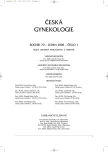-
Medical journals
- Career
Syndrome of Pseudomyxoma Peritonei – Description of Three Cases and Survey of the Problem
Authors: Z. Kinkor 1; M. Michal 2
Authors‘ workplace: Šiklův ústav patologie, LF UK, Plzeň, vedoucí prof. MUDr. M. Michal, PhD. ; Bioptická laboratoř, s. r. o., a Šiklův ústav patologie, LF UK, Plzeň, vedoucí prof. MUDr. A. Skálová, CSc.
Published in: Ceska Gynekol 2005; 70(1): 67-72
Category: Original Article
Overview
Objective:
To describe personal experience with three heterogeneous cases of pseudomyxoma peritonei. Review of the literature concentrates on the pathogenesis and biologic spectrum of the rare syndrome.Design:
Three case reports.Setting:
Private Biopsy Lab s.r.o. and Šikl’s Department of Pathology, Charles University and Faculty Hospital, Pilsen.Methods and Results:
Included are cases from Biopsy Lab s.r.o. and from personal consulting registry of Prof. Michal, Šikl’s Department of Pathology, Pilsen. Clinical presentation of three cases of pseudomyxoma peritonei documented is in details including long follow up. Broad variability of histologic appearance associated with different Clinical outcome is demonstrated. Immunohistochemistry performed by streptavidin-biotin system (LSAB+, Dako) as detection system, and diaminobenzidin tetrahydrochlorid as chromogen, employed three monoclonal antibodies – MUC2 (Novocastra, 1 : 400), cytokeratin 7 (Dako, 1 : 200) and cytokeratin 20 (Dako, 1 : 100).Conclusion:
Pseudomyxoma peritonei is a clinical syndrome defined as presence of massive mucinous, viscous material in the peritoneal cavity, both floating and adhering to serosal surface (jelly-belly). The histologic examination should always follow with detailed and precise description of the epithelial component. The cytological and structural quality of the epithelium constitutes two basic forms with entirely different nature biology and prognosis. First and more frequent, so-called disseminated peritoneal adenomucinosis, where primary low grade (benign) mucinous appendiceal tumor is almost constant finding, often recurs but displays favorable prognosis. Second, so-called peritoneal mucinous carcinomatosis is an extraordinary manifestation of peritoneal carcinosis following generalization of the gastrointestinal mucinous adenocarcinoma. Histopathogenesis in both types is thought to arise from MUC2 positive goblet cells in GI and ovarian involvement is secondary. A normal macroscopic finding on appendix or „uneventful“ appendectomy in anamnesis is not unusual.Key words:
pseudomyxoma peritonei – mucinous cystadenoma – ovary – appendix – mucocele – mucin – peritoneum – disseminated peritoneal adenomucinosis – peritoneal mucinous carcinomatosis – „jelly-belly“
Labels
Paediatric gynaecology Gynaecology and obstetrics Reproduction medicine
Article was published inCzech Gynaecology

2005 Issue 1-
All articles in this issue
- New Options in Pharmacological Treatment of Urge Urinary Incontinence in Women
- Importance of Registry of Aggregated Data on Women Giving Birth
- Analysis of Maternal Mortality in the Czech Republic in 2001
- Analysis of Present Diagnostic Methods of Intrapartal Fetal Hypoxia
- Contribution of Doppler Examination in Pregnancy at Risk of Alloimune Fetus Anemia
- Risk Factors of the 3rd and 4th Degree Tear during Delivery
- Birth Defects in the Czech Republic – Expected Incidence in the Coming Years
- Pelvic Exenteration
- Possibilities of Increased Radicality in Pelvic Exenteration
- Abdominal hysterectomy – Risk Factor in Development of Urinary Incontinence? Results of a Questionnaire Study
- MMP-26 mRNA and Estrogen Receptor Alpha Co-expression in Normal and Pathological Endometrium
- Protein bcl-2 Expression in the Mid-secretory Endometrium after Oral Estrogen-Progesterone Preparation
- Syndrome of Pseudomyxoma Peritonei – Description of Three Cases and Survey of the Problem
- Cystic Hypersecretory Carcinoma: Rare and Potentially Aggressive Variant of Intraductal Carcinoma of the Breast. Report of Five Cases
- Czech Gynaecology
- Journal archive
- Current issue
- Online only
- About the journal
Most read in this issue- Abdominal hysterectomy – Risk Factor in Development of Urinary Incontinence? Results of a Questionnaire Study
- Risk Factors of the 3rd and 4th Degree Tear during Delivery
- Syndrome of Pseudomyxoma Peritonei – Description of Three Cases and Survey of the Problem
- Contribution of Doppler Examination in Pregnancy at Risk of Alloimune Fetus Anemia
Login#ADS_BOTTOM_SCRIPTS#Forgotten passwordEnter the email address that you registered with. We will send you instructions on how to set a new password.
- Career

